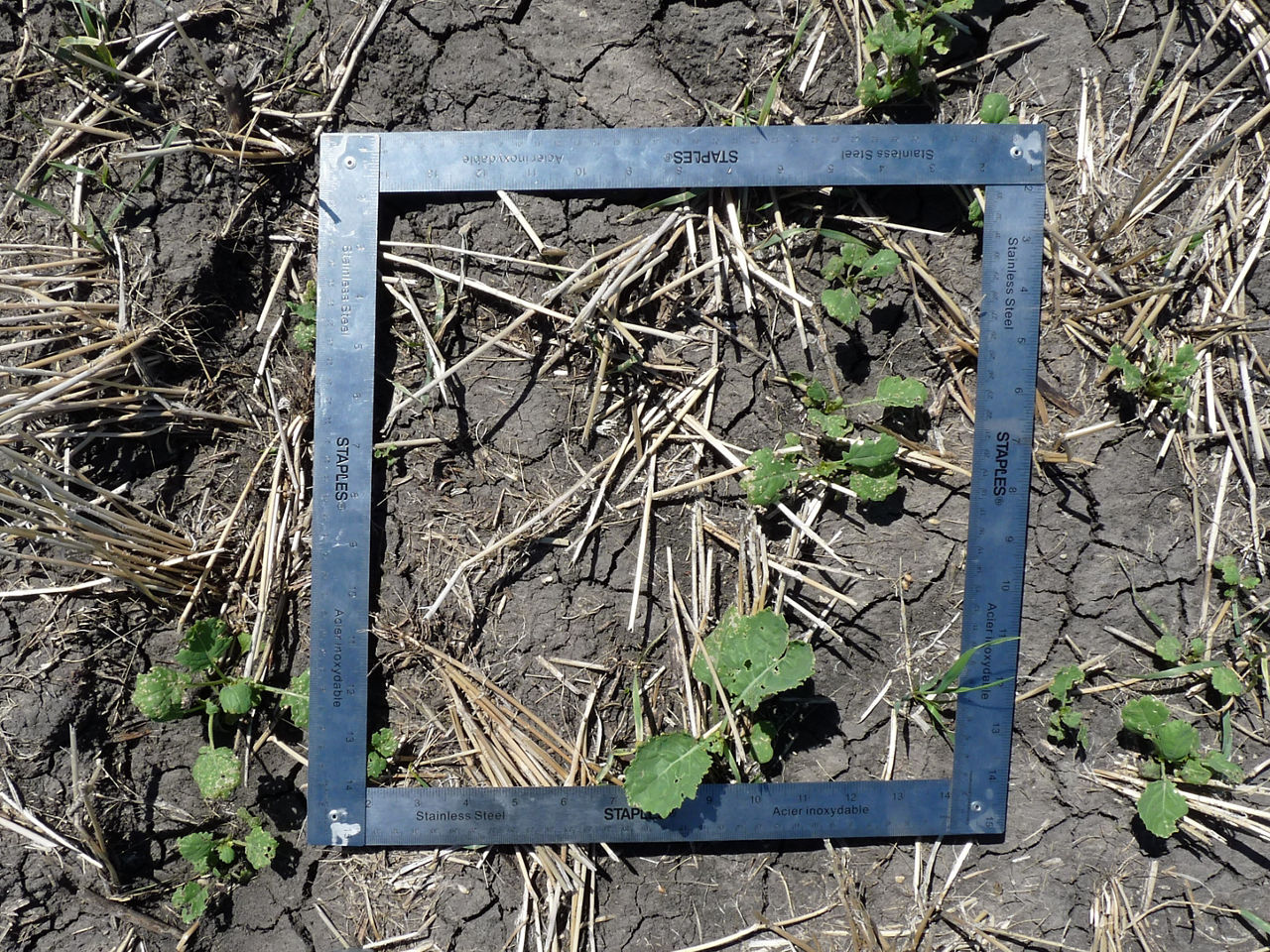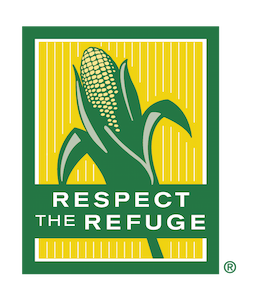8 MIN READ
Evaluating your Canola Stand: Did You Have the Right Seeding Rate?
August 29, 2021
How can I determine the three-leaf to four-leaf stage population in my canola field?
To assess early season plant counts with a hoop:
- Using imperial (plants per square foot) measurements: use a hoop with an area of two square feet, which will have an inside diameter of 19.3 inches and circumference of 60.2 inches. Count the number of plants inside the hoop and divide by two. To convert from plants per square foot to plants per square meter, multiply by 10. Note that using a hoop of this size will incorporate plants from two seed rows and give a larger sample size, helping improve accuracy of counts.
- Example: 16 plants ÷ 2 = 8 plants/ft2 or 80 plants/m2.2
Plant population counts should be completed in several locations across each field and averaged together to determine a field average for the number of plants per acre. Areas such as hill tops and low areas can have substantial variations in plant population counts, and depending on the size of these areas, can ultimately figure into the yield potential for that field.
What are some growing conditions that can negatively affect a canola stand?
- Poor seed to soil contact.
- Poor soil surface moisture.
- Early season frost.
- Heavy weed pressure.
- Insect pressure.
- Disease pressure.
Were planting conditions adequate for germination?
For a seed to start the germination process it needs to absorb moisture from the surrounding soil. If the planting equipment does not accurately place the seed in the top 0.5 to 1.0 inches of soil and that soil is not firmly packed (without large air pockets) around the seed, then the seed may not be able to take up enough soil moisture to complete the germination process. Canola seed size is very small and has very little seed surface area, so seed to soil contact becomes critical for uniform emergence. If there was poor seed to soil contact, the seed may not germinate at all or may have germinated but died due to the seed not absorbing enough moisture to complete germination. If the seed bed was in poor condition, then an increase in the seeding rate can help reach the recommended final stand of five to eight plants per square foot.
What seed bed conditions can lead to poor seed emergence?
- Poor soil surface tilth (cloddy soil)
- Wet soil conditions (poor seed slice closure)
- Soil compaction caused by tillage
- Heavy previous crop residue (seed planted into plant residue not soil)
- Poor soil surface moisture caused by tillage
Was the crop impacted by frost damage early in the growing season?
Canola seedlings can withstand a frost of 23 to 18˚F if plants have become acclimatized following a few days of cold temperatures. However, canola seedlings growing under warm conditions can be more susceptible to frost damage and can be killed by a slight frost. Ice crystals form on the leaf surface before they form within cells. The ice crystals that form in the leaf cells cause frost damage that can kill seedling canola. Canola in the cotyledon stage is more susceptible to frost damage than canola at the three to four leaf stage.3
Did the crop have heavy weed pressure that may have reduced plant vigor and plant establishment?
Weed management is essential for profitable canola production. Weeds should be controlled as early as possible since heavy weed competition early in the growing season can quickly reduce yield potential. The best herbicide plan for weed control in canola is to start with a clean field before planting with a preemergent herbicide program. Early weed pressure can compete with the canola crop for moisture, fertility and sunlight which can reduce vigor and cause stand establishment problems. If weeds are still a problem after emergence, then an in-season herbicide application can help reduce the weed pressure. Moderate to high plant densities can help improve crop competitiveness against early season weed growth because the canopy closes faster with more plants. With low plant populations, canola crops are slower to cover the ground and provide less competition to weeds in the early growth stages. If the grower knows that a field has the potential for high weed pressure, then an increased seeding rate can help the canola crop compete with weed pressure and help establish a high producing stand.
Was the crop damaged by early season flea beetle feeding?
Did seedling diseases cause poor emergence and poor stand establishment?
Lower than expected canola plant populations may be due to early-season infection by the soil-borne pathogens: Rhizoctonia solani, Fusarium and Pythium. These pathogens can cause seed decay, pre- and post-emergence damping-off (wirestem), seedling blight and seedling root rot.5 Tighter canola rotations can increase the severity of these diseases, especially in fields where a seed treatment was not applied. Seed treatments can help increase seedling emergence and growth of canola where these pathogens are present.6 Planting later into warmer soils can help avoid cool, wet soils favorable for disease to help contribute to adequate plant populations. Increased seeding rates for fields with short rotations and poor soil conditions can also help compensate for less-than-ideal growing conditions.
Can seed size influence final plant population?
The effect of canola seed size on crop emergence and yield potential is unclear. An Agriculture and Agri-Food Canada (AAFC) study in 2014 concluded that seed size, the thousand seed weight (TSW), did not have any significant effect on emergence, yield or seed quality.6 Over a wide range of Western Canada sites, seed sizes and conditions, only about 50% of planted canola seeds emerge above the soil surface.
Was enough seed planted to reach the desired final plant population?
The first important consideration is to determine if the seeding rate was adequate or if it should be adjusted based on target plant density (desired plants per square foot). As previously indicated, approximately five to eight plants per square foot is considered ideal. Seed size can vary greatly by seed lot, so knowing the TSW is important. Current varieties of herbicide-tolerant canola can vary between 3.5 grams per thousand seeds to 6.5 or more grams per thousand seeds.7 Once the seed weight (in grams) of 1,000 canola seeds it known it is vital to estimate the percent emergence. The percentage of canola seeds that emerge to develop into viable plants is typically in the range of 50 to 60 percent. A formula is available to help determine the number of seeds to plant to ensure that the target plant populations can be achieved.

A seeding rate calculator is available at https://www.canolacouncil.org/calculator/. 7
Low plant populations can cause low yield potential along with later seed maturity by up to 21 days, and excessively high plant populations can lead to problems besides high seed costs. Research has shown that canola can produce similar yields with plant populations ranging from 5 to 20 per square foot.3 In a canopy with more than 20 plants per square foot, stems can be very thin and pods may be concentrated at the top of the plants. A stand with this high of a population can be more likely to lodge, which may lead to the development of diseases like sclerotinia and make harvest more challenging.3
How can Bayer help the canola producer calculate the Target Plant Population (TTP)?
Target Plant Population is the Bayer method where each bag of canola seed is filled with no less than 4.25 million seeds per bag. The recommended seeding rate is 10 acres per bag to achieve a target plant population of five to eight plants/ft2. The TSW for each seed lot to be packaged is used to measure the correct amount of seed added to the bag to ensure each bag, no matter what the seed size, will be filled with no less than 4.25 million seeds per bag. This will help ensure growers have the right target seeding rate to get that target plant population. A chart has been developed to help the producer to adjust their seeding rate based on their known survivability, TSW and TPP.8

Additional factors such as soil temperature, fertilizer toxicity, seeding speed, seeding depth, seed placement, seed vigor, and dormancy can also affect germination and emergence and ultimately affect the number of plants surviving per acre.
Sources
1Whetter, J. 2019. What is the most economical seeding rate? Canola Digest. https://canoladigest.ca/january-2019/what-is-the-most-economical-seeding-rate/
2Canola Council of Canada. Canola Encyclopedia. Plant populations. https://www.canolacouncil.org/canola-encyclopedia/plant-establishment/evaluating-the-stand/
32021. Managing Frost Damaged Canola. Ontario Ministry of Agriculture, Food and Rural Affairs. http://www.omafra.gov.on.ca/english/crops/field/frdamcanola.htm
4Canola Council of Canada. Canola Encyclopedia. Flea Beetles. https://www.canolacouncil.org/canola-encyclopedia/insects/flea-beetles/
5 Canola Council of Canada. Canola Encyclopedia. Seedling disease complex. https://www.canolacouncil.org/canola-encyclopedia/diseases/seedling-disease-complex/
62020.Canola Council of Canada. Canola watch. Does seed size matter. https://www.canolacouncil.org/canola-watch/2020/01/15/does-seed-size-matter/
7Canola Council of Canada. Canola Encyclopedia. Seeding rate. https://www.canolacouncil.org/canola-encyclopedia/plant-establishment/seeding-rate/
8The right canola seed for the right Target Plant Population https://www.cropscience.bayer.ca/Products/DEKALB-Seed/Targeted-Plant-Population
5024_Q1








